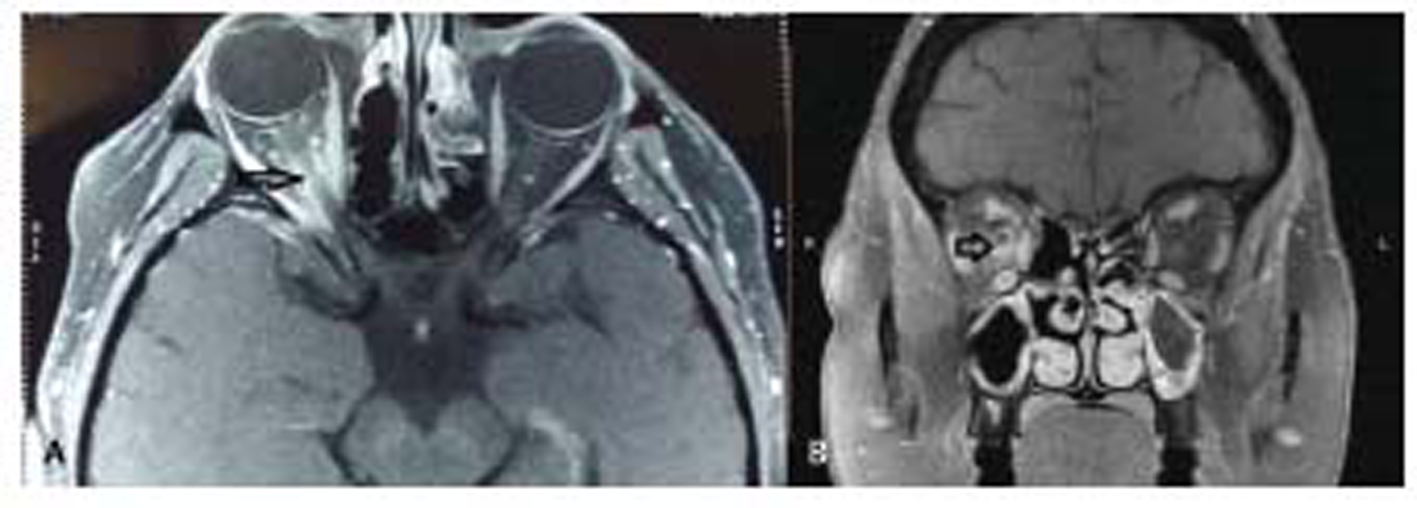Translate this page into:
Optic Perineuritis in a Case of Tolosa–Hunt Syndrome
Teena Mariet Mendonca, MS Department of Ophthalmology, Kasturba Medical College Hospital Attavar, Mangalore 575001, Karnataka India tmendonca87@gmail.com
This article was originally published by Thieme Medical and Scientific Publishers and was migrated to Scientific Scholar after the change of Publisher.
A 50-year-old woman presented with the complaints of recurrent episodes of right hemicranial headache for 7 months with binocular diplopia for 1 month. Headache was severe in nature with shooting type of right periorbital and retro-orbital pain. On examination, her visual acuity was 20/20 for distance and N6 for near in both eyes. She had complete ptosis and total ophthalmoplegia of the right eye. Right-eye pupil was 4 mm dilated and fixed. Left-eye pupil was 2 mm reacting to light. Fundus examination showed optic disc edema in the right eye. We arrived at a clinical diagnosis of total ophthalmoplegia with orbital apex syndrome on the right side. Her visual field examination (Humphrey 30–2) was normal in both eyes. Magnetic resonance imaging (MRI) study orbits (plain) showed ill-defined T1 and T2 isointense areanoted in the right orbital apex and superior orbital fissure. Contrast-enhanced MRI orbit images (Fig. 1A) showed right optic nerve sheathenhancement predominantly in the orbital apex. Coronal sections showed "doughnut-"shaped enhancement, and axial sections showed "tram track" enhancement (Fig. 1B) around the optic nerve suggestive of optic perineuritis. She underwent extensive workup to rule out autoimmune and infective conditions. The patient was diagnosed with Tolosa–Hunt syndrome with optic perineuritis. She was treated with intravenous methylprednisolone 1 g/day for 5 days followed by oral prednisolone 1 g/kg body weight with a slow taper. Dramatic improvement in her symptomswas noted within 48 hours of steroid administration. She was relieved of headache and diplopia. Her extraocular motility improved significantly, and disc edema resolved after a week of starting steroids.

-
Fig. 1 Contrast-enhanced magnetic resonance imaging brain with orbits (T1-weighted image) axial section (A) showing ill-defined homogenously enhancing area noted in the right orbital apex. "Tram track" enhancement (arrow) of the optic nerve sheath in the axial section and "doughnut-"shaped enhancement (arrow) in the coronal section (B) can be noted.
Fig. 1 Contrast-enhanced magnetic resonance imaging brain with orbits (T1-weighted image) axial section (A) showing ill-defined homogenously enhancing area noted in the right orbital apex. "Tram track" enhancement (arrow) of the optic nerve sheath in the axial section and "doughnut-"shaped enhancement (arrow) in the coronal section (B) can be noted.
Tolosa–Hunt syndrome, also called syndrome of painful ophthalmoplegia, is a diagnosis of exclusion. The syndrome results in periorbital or hemicranial pain with ipsilateral paresis of oculomotor nerves due to nonspecific inflammation at the orbital apex or superior orbital fissure.1 Optic perineuritis is an uncommon variant of idiopathic orbital inflammatory disorder, involving the optic nerve sheath and surrounding tissues.2 Contrast-enhanced MRI orbits is the diagnostic modality of choice. Visual outcome after treatment with corticosteroids in patients with optic perineuritis is generally good.3
Conflict of Interest
None declared.
Funding None.
References
- Optic perineuritis: clinical and radiographic features. Arch Ophthalmol. 2001;119(9):1299-1306.
- [Google Scholar]
- Idiopathic inflammatory pseudotumor of the orbit and Tolosa-Hunt syndrome-are they the same disease? J Neurol. 2002;249(9):1237-1241.
- [Google Scholar]





